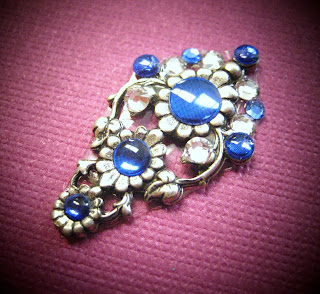Blown glass beads and buttons have been around for a long time, hundreds of years. However, finding vintage and antique hollow glass beads and buttons is always a special treat, because blown beads and buttons are fragile and easily broken, so there is considerable loss over the years.
In the early 1800’s in Bohemia, a large selection of blown glass beads was available, including various colors, silver lined, faceted, irregularly shaped, and so on (Jargstorf 1998). These are blown glass buttons from my personal collection, and are Bohemian glass from the 1800’s. They were individually blown of clear glass, lined with a coating to make them look like pearls, and finally had their delicate glass shanks attached.
You can see these 3 components – thinnest possible glass – pearlized coating – shank – in this broken button.
Making the vintage mercury glass beads that are familiar as vintage Christmas decorations is a bit different. First a long thin tube of hot glass is blown into a mold, creating a series of hollow bulges at regular intervals. The tube is then coated or lined on the inside with a silver nitrate solution. Finally the tube is cut between each bulge to create the individual beads.
Back in the early 1800’s, the solution used to line the beads contained mercury, thus the historical name. By the mid 1800’s in Bohemia, the lining solution had switched to be a combination of silver nitrate, water and sugar. In Bohemia in the 1870’s two important innovations were introduced: a mold that allowed up to 8 beads to be blown at one time and a pump to line the beads mechanically, instead of by sucking by mouth, although the “by mouth” method did continue to be used, related to the cottage industry character of the Bohemian glass making industry (Jargstorf 1998).
Cutting the beads apart leaves a characteristic “neck” on these vintage beads and results in beads that are each unique in character. It also means that the edge around the hole of these beads is sharp, so remember to choose your stringing material with this in mind. The fact that these beads are lined with a silver solution explains why sometimes vintage mercury glass beads can look tarnished - they are :)
At Bumbershoot Supplies, we have a few types of vintage blown hollow beads. These black hollow glass beads are from Czechoslovakia. These were made with black glass and blown into a textured mold that results in gentle facets on the outside of these beads. These hollow beads are relatively thick and study even as they are light in weight.
We also have available vintage Japanese mercury glass beads in both silver and gold, as shown in the photos throughout this article. Gold mercury glass beads are made with amber colored glass, lined with silver nitrate solution to make them golden. Our gold and silver beads are typical of vintage mercury beads, light and delicate.
References:
Peter Francis Jr. Beads of the World, 2nd Edition. Schiffer Publishing Ltd, 1999.
Sibylle Jargstorf. Glass in Jewelry. Hidden Artistry in Glass, 2nd Edition, Schiffer Publishing Ltd, 1998.














































